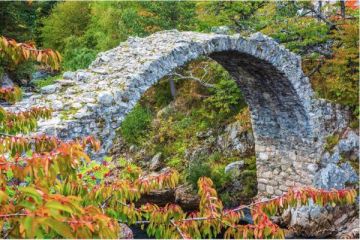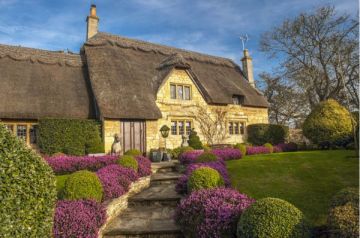by Joanne Paul
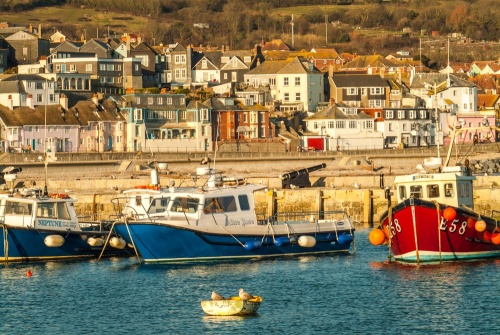
"In June of 1757 a mermaid was thrown up by the sea on the Chesil Beach between Burton and Swyre." I was reading by the duck pond at my favourite guesthouse in Frampton, when I happened to come across Harry Ashley's account of this strange creature it was 13 feet high, or if you prefer your mermaids lying down 13 feet long. I doubt if Darryl Hannah, star of the film Splash, need be concerned; her reputation as the most beautiful mermaid ever is still intact. This creature washed ashore in 1757 was no beauty. John Hutchens, the respected Dorset historian, also relates the finding: "The head was partly like that of a man and partly like that of a hog. The fins resembled hands and it had a masculine jawbone with 48 teeth in both the upper and lower jaw."
Accounts of this sea creature appear in many authenticated records. It seems it is only one of hundreds of exotic cast-ashore objects that have been found over centuries along the shore of Chesil Beach in England's County of Dorset
Legend has it that this mighty bank of pebbles stretching from Burton Bradstock to Portland 15 miles away was washed up in a single night, but the truth is it was pushed into place during the Ice Age. It is composed of chalk, flint, and rocks from distant places. It stands on Kimmeridge clay and when gales blow and bare the clay, Roman and medieval coins, rings, and gold and silver bars have been discovered, the loot from centuries of shipwrecks including treasure from the Spanish Armada. Recently a World War II bomber engine was recovered. The bank is separated from the Dorset mainland by the Fleet, a narrow sea lock or lagoon whose width varies from two hundred to a thousand yards.
In his Dorset Village Book Ashley claims that on a summer day it looks like a giant snake snoozing at the water's edge. Even though Ashley calls it an awful place and is haunted by a childhood memory of a great steamer, with her propeller in the air, ending her days grinding herself into the beach, I resolved to see this fascinating part of the Dorset Coast. Accounts of thousands of seamen lost to its wild majesty only stimulated my interest.
I remembered reading John Mead Falkner's novel Moonfleet. The book's two smuggler heroes are shipwrecked on the beach and fight desperately against the terrific undertow. Only one of the two men lives, his survival assured by the self-sacrifice of the other.
My romantic inclinations were further stimulated when I read about St. Catherine's Chapel that stands on the summit of a hill overlooking the Chesil Beach. Any chapel dedicated to the patron saint of spinsters must be worth a visit. I didn't need any assistance myself but I wanted to see this 15th-century structure where local girls came to ask the saint for help finding a husband.
I consulted my portable library of guide books and found Elizabeth Gundry's description of the Manor Hotel in West Bexington most appealing. She calls it "an elegant stone house close to the sea, Lyme Bay and Chesil Beach--where good silver, candle lamps, and nosegays are on every apricot clothed table. Bedrooms are spacious; most have sea views and colour TV as well as their own bathroom and WC. Breakfast in bed is available!" What more could I ask? I phoned from Frampton and booked for three days starting on Thursday of the following week
This time I cheated. I took a taxi! I like to brag that I can reach any spot in Dorset on public transportation, but the truth is although I can reach any spot, sometimes my heavy luggage cannot. Maybe if I could stop buying every book I see about Dorset I wouldn't be so weighted down. But it's not really a problem because I've found that I can reach almost any spot in Dorset by taxi for about 20 pounds. The cheapest daily car rental would be considerably more. I can cope with L.A.'s intricate freeway system but I'm still too chicken to drive in England.
The ride to West Bexington was really a bargain. Not only was I and my luggage safely delivered from one doorstep to the other, I got a free lecture about the state of Britain's economy from my driver along the way. The only problem with my way of travelling and my decision to stay in one county and try to explore it in depth rather than trying to cover all of England in one short trip, is that I often arrive at my new destination much too early. Travelling only fifteen or twenty miles between stops means that if I check out at 10:00 AM I usually arrive before 11:00 AM
The startled look on Richard Child's face when I arrived at the Manor Hotel at 10:30 was typical of the welcome I receive at most of my hotels and guest houses. I can tell that my host or hostess is thinking: "what's this crazy American woman doing here so early? The beds aren't even made yet." I quickly assured Mr Childs that if he would just let me leave my cumbersome luggage I would disappear and not return until late afternoon.
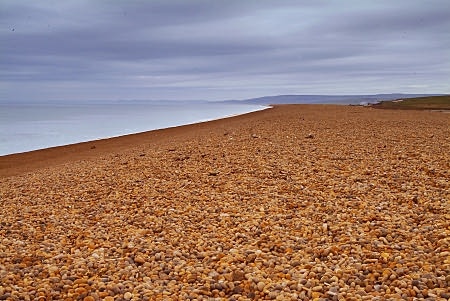
I remembered to grab my Ordnance Survey Map of the area before setting off. I decided to save exploring Chesil Beach until the next morning and instead walked the mile or so back up the road to the pretty village of Swyre and found a footpath in the back of the Bull Inn that led to the even prettier village of Pucknowle (pronounced Punnel) that lies behind a curious circular hill called the Knoll, 600 feet above the sea. It has lots of stone buildings and farmhouses and an ancient church that contributes to a feeling of enchantment
At first I thought the church was deserted but as I entered, music suddenly flared-up from the organ. Organ music is not my favourite thing but in Pucknowle's Church of St. Mark is seemed quite lovely. I stood by the Chancel Arch as the sun streamed through the stained glass windows and watched the elderly gentleman seated at the keyboard. He thought he was alone so after a while I tiptoed out into the churchyard.
The feeling of enchantment increased when I peered over the church wall and discovered a handsome hamstone manor house with round-headed mullioned windows and a well-kept garden. I learned from my guide book that the lovely porch on the front wing was built in 1650. I also learned that the manor was once occupied by Henry Shrapnel in the early 19th century. He gave his name to a shattering invention and died a general in 1842.
As I was standing in front of the church wondering what to do next a village woman passed by with her Jack Russell terrier. She asked if I needed directions. I inquired about the food at the picturesque stone and thatch Crown Inn across the road. She assured me the fare was first-rate and then told me how to find a different footpath back to West Bexington so I wouldn't have to retrace my steps. I have found wherever I go in Dorset perfect strangers seem eager to help me. I hope it's not because I look helpless. I've decided that it's simply because Dorset people are genuinely nice.
After an excellent smoked mackerel Ploughman's at the Crown I took a few pictures of the village and countryside, then found my way back to the Manor Hotel and my waiting room with my luggage sitting inside the door. I wasn't disappointed. The sea view was splendid. I could clearly see the notorious Chesil Beach.
In the morning after breakfast it was time to check out the "awful, haunted" Chesil Beach that has earned such a bad reputation. I decided to walk along the coastal path to Abbotsbury, four miles to the East. A noble-looking black Labrador who lived at the hotel walked along with me until we came to the pebbly beach. Then he slid down the pebbles on his tummy and ran up and did it again. Then he rolled around on his back on the pebbles with a look of pure ecstasy on his silly face.
So far the Chesil Beach seemed very benign. It wasn't living up to its reputation as a deathtrap to up-channel sailors but I could hear the sound of the shifting pebbles on the other side of the narrow wall and well believe that there is a deadly undertow or rush back of water that could suck them off their legs and carry them under the thundering waves
The walk to Abbotsbury took about an hour and a half and only ten minutes more to climb the bare hill to St. Catherine's Chapel. Here, one day a year, spinsters could pray for a husband
A husband St. Catherine
A handsome one St. Catherine
A rich one St. Catherine
A nice one St. Catherine
And soon St. Catherine!
The verse is carved on the chapel's inside wall. The chapel and the huge tithe barn nearby are about all that remains of the 14th-century abbey that once dominated this part of Dorset. The Benedictine monks started the Swannery that still flourishes today where 400 to 800 mute swans make their home in the breeding season. The chapel survived the dissolution of the monasteries because it was useful as a seamark. From the top of Chapel Hill I had splendid views in all directions. I could see back across the village with its pretty 17th and 18th-century cottages built with the local orange ochre limestone, many had thatched roofs. I could see along the Fleet (the narrow lagoon) to Portland Bill and west across Lyme Bay with the Subtropical Gardens in the foreground
I followed the signs leading to the Subtropical Gardens and found a whole valley filled with trees of all sorts. Because it's so close to the sea and has shelter belts of evergreen oaks, the gardens are virtually frost-free, so many tender plants can be grown. I saw breathtaking camellias and rhododendrons and drifts of daffodils in the orchard. There were miles of winding walks, and a stream with ponds. All very beautiful but I remember it most of all because it was in this garden that I was amazed to find the best cup of coffee I've ever had in England.
England is a country known for its tea-making skills but it rarely receives compliments on its coffee. At least I rarely can find a cup I enjoy, so I was delighted to find the perfect cup at the restaurant and tea house in the Abbotsbury's Subtropical Gardens. I even had my choice of cream, half & half instead of only plain milk. And! The cups were double normal size! While I drank my coffee on the porch of the teahouse a snow-white peacock displayed his beautiful tail in front of me. It really was a red-letter day
There were fishermen planted all along the coast as I walked back to West Bexington. It was almost as if they had measured the space between stations so that there would be a man every fifty feet. I saw two deer and three large hares cross my path at different intervals. I decided there was no place I would rather be than on this stretch of Dorset Coastal Path. I didn't find it nearly as forbidding as Harry Ashley had led me to believe. I wouldn't have been surprised to see King Arthur emerge from the mist followed by Lancelot and Gawain on their way to the Round Table.
On my last day at West Bexington I walked up to Swyre on the B 3167 Highway and caught the Southern National No. 210 bus on its way to Lyme Regis. At Lyme I had tea in a little tearoom with Laura Ashley wallpaper once visited by Jane Austin and then explored the beach where in June of 1685 the Duke of Monmouth landed with eighty followers and a vague plan for seizing the English crown.
I visited the museum on Church Street and inspected its collection of memorabilia dating from the time Lyme was a major medieval port trading wool for wine. John Fowels is the curator and takes his job very seriously. It's hard to realize that the same man who wrote the steaming, erotic passages in The French Lieutenant's Woman and Mantessa can be so earnestly concerned about the museum's leaky roof and its inadequate heating system.
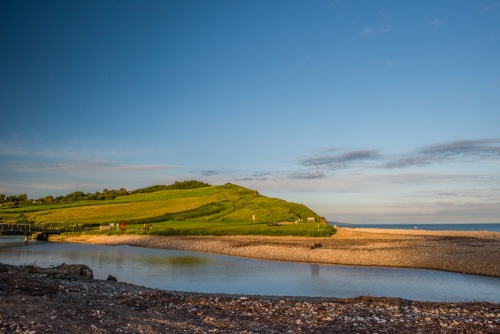
I walked out on the Cobb and pretended to be Meryl Streep as she appeared in the French Lieutenant's Woman with the wind dramatically lashing the waves in the background. I did all of the things a tourist usually does in Lyme but I had one distinct advantage. I didn't have to worry about a place to park.
Lyme's quaint narrow winding streets can become a nightmare when congested with summer traffic. When I arrived fresh from my carefree bus journey I could immediately enjoy all Lyme had to offer. When it was time to leave I caught the No. 210 in front of the Post Office and again enjoyed the ride on a double-decker through the pretty villages of Burton Bradstock, Chideock, Charmouth and the beautiful coastline
I was so impressed with the countryside around Pilsdon Pen and Lewesdon Hill I could hardly wait to get back to my portable library to see if I could find a listing for a B&B in the Marshwood Vale. How can any other way of travelling bring so much pleasure? I felt very smug because I've found a way to enjoy the best of both worlds. I know how to escape the worry of driving in unfamiliar territory where intimidating road maps and the fear of getting lost can spoil a holiday.
I've avoided the obvious alternative: the guided tour where transportation, overnight accommodation and all details have been packaged and programmed by professionals. I've discovered one of England's National Treasures that few tourists take advantage of. I've discovered the country bus! However, I have been stranded a few times and have missed the last bus back to my base so I always carry my secret weapon: a network of taxi driver's phone numbers in every part of Dorset. They've come to my rescue several times. But even then I'm still ahead of the game. A car rental would be much more expensive.
